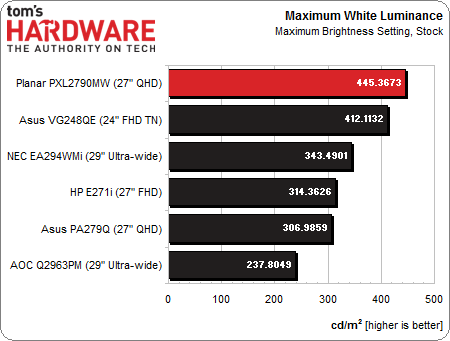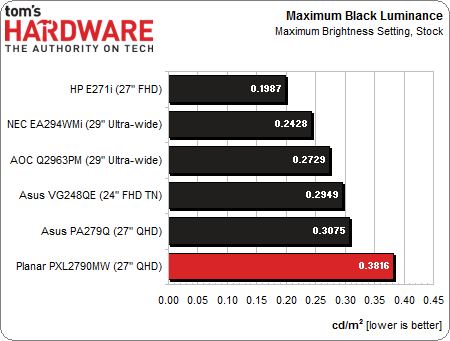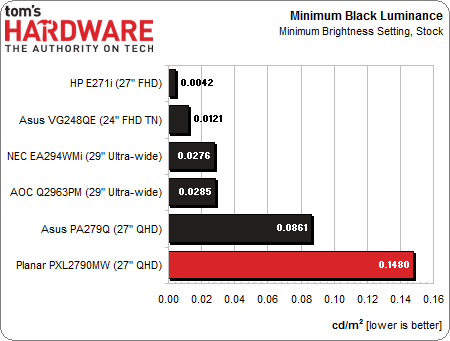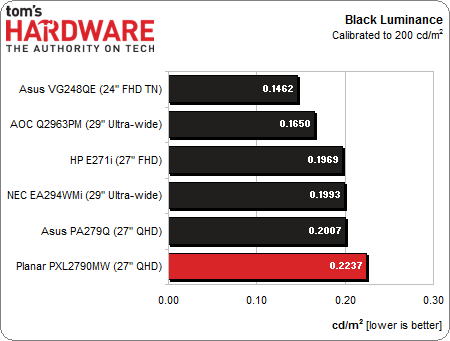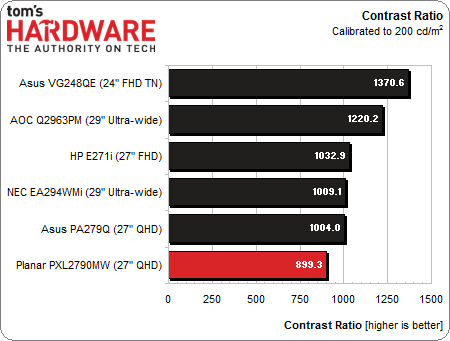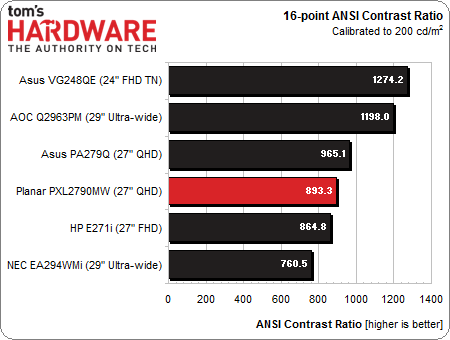Planar 27" QHD Monitor Review: Clarity Like We've Never Seen
Planar sent over its newest QHD screen, the 27" PXL2790MW. This is the sharpest display we’ve ever seen, and one of the most accurate. With high-end styling and a 2560x1440 native resolution, it introduces a sense of luxury to the business class.
Results: Brightness And Contrast
Uncalibrated
Before calibrating any panel, we measure zero and 100 percent signals at both ends of the brightness control range. This shows us how contrast is affected at the extremes of a monitor's luminance capability. We do not increase the contrast control past the clipping point. While doing this would increase a monitor’s light output, the brightest signal levels would not be visible, resulting in crushed highlight detail. Our numbers show the maximum light level possible with no clipping of the signal.
Our comparison group for this review is the last six displays that Tom's Hardware reviewed.
It seems like every new monitor we receive is brighter than the last. When you turn the PXL2790MW’s brightness control to 100, you are rewarded with over 445 cd/m2 of luminance. That's so bright in our test environment as to border on painful. Even with a lot of ambient light, fatigue quickly sets in if you try to use the display dialed all the way up.
It also has a negative impact on the maximum black level.
Considering the extreme output level, .3816 cd/m2 isn’t a bad result, though. If you max out brightness like this, blacks look grayer, even if the overall contrast is decent.
Here’s the final contrast result.
This is decent on/off contrast for such a bright display. One thing that could make the PXL2790MW even more versatile is separate backlight and brightness controls. That way, we could improve contrast by turning down the backlight, but leave the brightness at a level that preserves detail. The monitor has plenty of dynamic range; it’s just concentrated at a brightness level that is too high.
Get Tom's Hardware's best news and in-depth reviews, straight to your inbox.
For the next group of measurements, we turn down the brightness control to its minimum setting and leave the contrast unchanged. The PXL2790MW measures 174.7655 cd/m2, which is way above our minimum standard of 50 cd/m2. Below that, you risk fatigue and eyestrain. However, the monitor is too bright for a completely dark room. To reinforce our above comment about dynamic range, there is plenty available. It's just at a higher brightness level than necessary. A backlight control would allow the user to pull that down while retaining (or even improving) the display’s already solid contrast.
A .1480 cd/m2 measurement is respectable, but it could be so much lower if the overall brightness level weren’t so high. We do experience a quality black level, though. Dark areas in movies and games look nice and detailed, mainly due to the PXL2790MW’s excellent gamma performance.
We’ll wrap up this section with the minimum contrast comparison.
The minimum contrast number is only slightly higher than the maximum one, which shows consistency. While our result is very good, there is potential for even better contrast with the addition of a backlight adjustment, or a brightness control with greater range.
After Calibration
Since we consider 200 cd/m2 to be an ideal point for peak output, we calibrate all of our test monitors to that value. In a room with some ambient light (like an office), this brightness level provides a sharp, punchy image with maximum detail and minimum eye fatigue. It's also the sweet spot for gamma and grayscale tracking, which we'll look at on the next page.
We start with the calibrated black level. This can sometimes rise a bit from the monitor’s default state. We consider the tradeoff in contrast well worth the gain in color accuracy.
After calibration, the PXL2790MW’s black level is only a little higher than its minimum number, mainly because of the high minimum white level value. With a backlight control, it would be possible to lower the peak white enough to generate much better blacks.
Here are the final calibrated contrast numbers.
While 899.3 to 1 contrast won’t break any records, it still represents a solid performance. Thanks to its unequaled clarity and nearly perfect gamma, the PXL2790MW’s perceived contrast is a good deal higher than the measurements would indicate.
ANSI Contrast Ratio
Another important measure of contrast is ANSI. To perform this test, a checkerboard pattern of sixteen zero and 100 percent squares is measured. Our benchmark is somewhat more real-world than on/off measurements because it tests a display’s ability to simultaneously maintain both low black and full white levels, and factors in screen uniformity. The average of the eight full-white measurements is divided by the average of the eight full-black measurements to arrive at the ANSI result.
Although a result of 893.2:1 is pretty good, it could have been much better had there not been hotspots on the left side of the screen. The black squares there are visibly brighter than the rest. The PXL2790MW does suffer from a black uniformity issue, at least in the sample we tested. Had our measurements been a little more consistent, the ANSI contrast would easily have topped 1000:1.
Current page: Results: Brightness And Contrast
Prev Page Measurement And Calibration Methodology: How We Test Next Page Results: Grayscale Tracking And Gamma Response
Christian Eberle is a Contributing Editor for Tom's Hardware US. He's a veteran reviewer of A/V equipment, specializing in monitors. Christian began his obsession with tech when he built his first PC in 1991, a 286 running DOS 3.0 at a blazing 12MHz. In 2006, he undertook training from the Imaging Science Foundation in video calibration and testing and thus started a passion for precise imaging that persists to this day. He is also a professional musician with a degree from the New England Conservatory as a classical bassoonist which he used to good effect as a performer with the West Point Army Band from 1987 to 2013. He enjoys watching movies and listening to high-end audio in his custom-built home theater and can be seen riding trails near his home on a race-ready ICE VTX recumbent trike. Christian enjoys the endless summer in Florida where he lives with his wife and Chihuahua and plays with orchestras around the state.
-
stoogie 16.2ms SMTT reviewed catleap or crossovers from greensum/korea LG S-IPS have been out for well over 2 years now at a $300 or less starting price. Get with the times toms.Reply -
Bondfc11 I agree with stoogie - also Toms needs to get an Overlord tempest and take a look at a real gaming 1440 panel that can do up to 120hz refresh rates. This screen isn't that special and the housing has been around in other variants for a year now as well.Reply -
tpi2007 445 cd/m2 of luminance as maximum and 174.7655 cd/m2 as minimum ? Why do monitor manufacturers insist on delivering brighter and brighter monitors ? People don't use them like they are on display in a very well lit showroom, if you want to use one of these at home with just an indirect light source on the wall for some gaming at night, you're out of luck, this doesn't even reach the industry standard of 120 cd/m2 as adequate regular brightness, let alone the 50 cd/m2 that Tom's and many others consider an acceptable minimum to have in a darker room.Reply
-
s3anister Reply12033250 said:no award?
What do you seriously think that another 27" 2560x1440 60Hz monitor that is already in class with a dozen other models identical to it, deserves an award? -
DarkSable Looks exactly like the "new" QHD Iiyama. Doesn't perform well. Costs a lot. What's the advantage, again?Reply
As for those overlord monitors, I wasn't impressed by them, mostly because I had it sitting next to a lightboost 2 120hz TN panel. Yes, the overclocked IPS panel has better colour (though that's largely negated by using it on minimal brightness in a dark room, like we've already been talking about), and it's certainly pretty and gives a lot of screen real estate... but it can't compare to a real 120Hz monitor, especially not one with a strobing backlight. -
WyomingKnott "With the new PXL2790MW, we quickly discovered there was no need for scaling in any program. The image is so clear that even the smallest text is fully legible." Technically admirable, but not enough for people like me with middle-aged eyes. The more pixels per inch, the happier my eyes are, but they still want decent-sized fonts.Reply
Now this sort of monitor clarity plus an OS that supports decent enlarged fonts would be really nice. Apps that scale well over a range of sizes would be even nicer. A 1000 pixel wide frame may be good for some people no matter how small it is; others of us would like at least a certain number of inches. Support all of us.
(Yes, I know that this isn't the monitor's fault. It's a poor convention in many parts of the software industry.) -
warezme I have never had a major problem with text clarity with pretty much any LCD since the first thing I make sure to do is set the panel or monitor to native resolution hardware scaling and turn off all windows text or font smoothing and windows set to the same monitor native resolution. I haven't seen one of these 2560 screens in person but I have experienced the default font issue that happens when you try and let windows smooth or scale. I don't like monitors with radiused corners because that makes the bezels even thicker then they need to be. I also don't like the way most monitor manufacturer try to hide the input plugs by making them inset and pointing down. It is a pain to try to plug or unplug anything when you can't see the plug without laying the monitor on its side. Also it makes no use to label the inputs if they are inset dark on dark. Make the text white.Reply -
-Fran- This deserves a "meh" award at most.Reply
QHD is not ready for gaming prime time yet, sorry folks.
Cheers!
